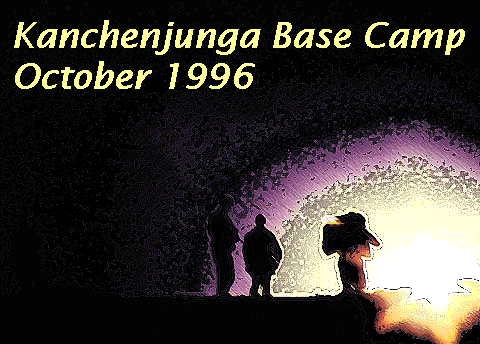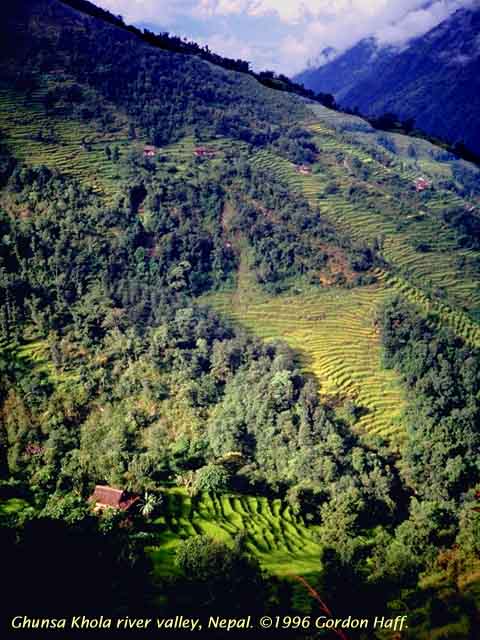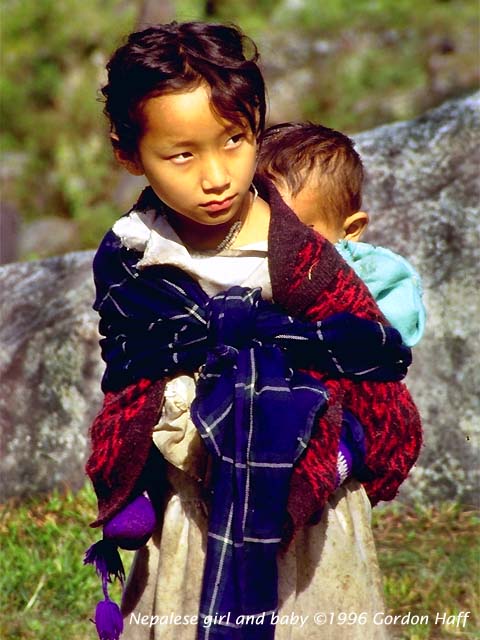


 Ghunsa Khola river valley, 640x480 JPEG, 50K
Ghunsa Khola river valley, 640x480 JPEG, 50K
Girl with baby, 640x480 JPEG, 50K
About four years after the previous Manaslu trek, I returned to Nepal in the fall of 1996 for another of the "classic" longer treks - this one to the base camp of Kanchenjunga. This trek had been recommended to me from a number of sources including a writer, Kev Reynolds, on my previous trek. I had looked around at other possibilities including the Dolpo region (very pricey because of trekking permit fees), a glacier traverse from Makalu to the Everest area (not running that year), and various "trekking peaks" (ultimately a long way to go to basically bag a minor summit).
The adventures in transit through Biratnagar were described earlier in this narrative and don't bear repeating here. Suffice it to say that airplanes and high mountain passes and narrow grass strips are an exciting but not especially efficient or healthy combination. Notwithstanding a day's delay and a number of false starts, our plane was able to eventually poke its head through a (sort of) hole in the clouds and land at Suketar, a small airstrip perched on a ridge above the village of Tapeljung. Much wheeling around through valleys was involved in this process, and it is somewhat disconcerting to see the target airstrip above your head.
Within the next hour visibility reduced to zero again and, after a quick tea and soup, we departed through the mist to our first campsite about three hours away. The trail was slick in spots and there was evidence of heavy erosion. Leeches were a less welcome attraction of this walk as well. (Leeches would be off-and-on pests throughout the lower sections of the trek.)
 Field of Grain, 800x600 JPEG, 143K
Field of Grain, 800x600 JPEG, 143K
For the next week or so we made our way up the (relatively) lowland valley formed by the Ghunsa Khola. (Valley perhaps carries a hint of mildness which isn't really appropriate. In fact there were many steep sides and boulders which necessitated the great ups and downs which often characterize trekking in Nepal. The term "Nepali flat" is used to describe this sort of terrain. It might be defined as a day of no elevation change which in fact involves going up and down a thousand feet three or four times.) It was warm and somewhat sticky down here in the five to seven thousand foot range but camping generally near the riverbanks made for easy (and welcome) washings.
Food was the usual mix. Breakfast usually consisted of either "pancakes" (a dense crepe-like, if decidedly non-French, concoction) or eggs of some variety. Lunch consisted of items such as blood sausage, Spam (in the usual trek concession to bad English food), "pizza", cabbage, beans, fried bread, tinned fruit, etc. Dinners included noodles, fried rice, and mu mu's (dumplings) with custard or cake for dessert.
After about a week, we began our climb into the high country with the steep-walled river canyon widening into a broad glacial valley. The river itself remained a raging torrent and kept up with us on our climb (about 400 ft. per mile). With Phele, we arrived at the first of the high mountain villages we would pass through. The lama showed us through the interior of the monastery. The contents could only be described as some rather eclectic mixes, old sharing with new: old carpets and hangings shared wall space with modern photographs of the Dalai Lama and other postcards and photos.
Ghunsa is a fairly substantial town in sort of a spread out structure. Some very nice cottage industries including some very nice carpets which, were it not for the carrying, I'd have preferred to those in Kathmandu. The weather was cooling, but also clearing - a welcome change.
A local woman was suffering from a toothache and Jan and Claire (our two English vetinarians) attempted to handle the extraction with my Leatherman pliers, but the tooth was too well set at present so they gave her antibiotics and painkillers in the hope that it would ease the pain while the tooth roots loosen. (Do not expect to see this particular usage advertised by Leatherman anytime soon.)
As the chill on the second day began to set, we had tea in a local house (actually that of the woman with the toothache). Dark and smokey - Nepalese houses typically lack the (one would think) rather basic innovation of the chimney. In all fairness, however, most of the smoke goes up and through an opening on the second floor and filters through the roof.
Trekking up from Ghunsa, the effects of altitude became more and more apparent. The valley was comfortably wide but to somewhat make up for it the glacial scree became more pronounced and difficult to cross. Snow-covered peaks poked up throughout this section and the setting at the next village of Khambachen was spectacular with Jannu and its sister peaks dominating the skyline.